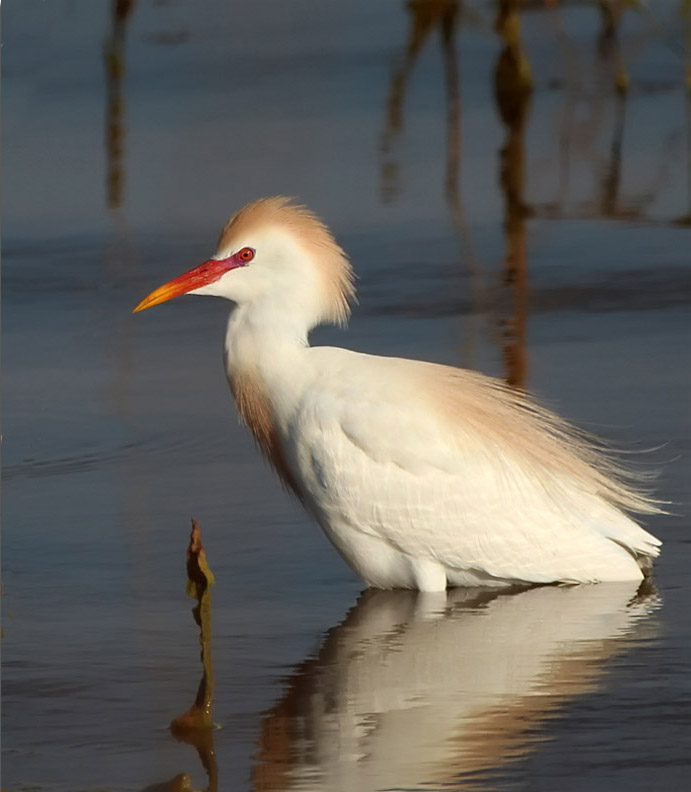
by John Shackford
The Cattle Egret (Bubulcus ibis), is probably the most common heron in Oklahoma today. According to Cornell University’s website on birds, the Cattle Egret was found, originally, only in Africa, then “somehow reached northeastern South America in 1877…arriving in the United States in 1941…and nesting there [in U.S.] in 1953” Looking at Dr. George Sutton’s Summaries of Oklahoma Birds [1982], the first report of the Cattle Egret in Oklahoma was about 1962.
I believe it is accurate to say that all egrets are herons, but not all herons are egrets. The difference between the two is somewhat inexact, so trying to pin the difference down is difficult: as a general rule, egrets are white or mostly white and most of them have large plumes somewhere on parts of the head, neck or back during the breeding season, but not all year long. There are enough exceptions to these rules that these are not very satisfying categories, so let’s just move on.
Thinking that the Bethany heronry would support my belief that Cattle Egrets were the most common heron here in the Oklahoma City area, I went there on 24 May 2014: I wanted to give (a) the exact directions to the heronry, (b) that heronry’s composition of birds, and (c) what was going on there. Exact directions to getting there are to go to NW 10th and N. Council Road, at this intersection go west on NW 10th for one-tenth of a mile, turn south (left) at the large Thousand Oaks sign on the south side of the road and go one-tenth mile south into the Thousand Oaks entrance, and park at the wide spot in the road there. You will be in the heart of the heronry, indicated by dead oaks in the immediate vicinity. I would point out that this destination makes for an easy, cheap (doesn’t take much gas) and informative “field trip.”
I arrived about 4:25 pm and stayed until 5:34 pm, when it started raining (YES!) Immediately, upon arriving, I saw a small white egret—either a Snowy or Cattle Egret–picking up a stick on the ground. Then I noticed other Snowy and Cattle Egrets on the ground. At 4:27 I saw a Great Egret flying by, then saw a Great Egret rearranging sticks at its nest. I counted Great Egret nests readily evident and saw at least 38 nests; these nests were about 30-40 feet above ground and in dead trees. After 15 minutes or so of observing and one (and only) time stepping out of my car (like I say, this is an easy field trip), I estimated that there were + 100 Great Egret nests, where they had primarily staked out nests in dead oaks in the center of the heronry; most of these nests appeared to have young. Other species of herons observed in the middle of the heronry that day were 6-10 Snowy Egrets, 5-7 Black-crowned Night-Heron, and 2 Little Blue Herons, only a small sample, I believe, of all the herons nesting close by. These 4 species of herons had claimed the prime sites in the heart of the heronry. Some 30-40 Cattle Egrets I saw that day were on the ground toward the periphery—rather than the middle—of the heronry. In fact, and to my surprise, I never saw an actual Cattle Egret nest as I casually looked for them from my central vantage point within the heronry, although I did see a number of Cattle Egrets searching for twigs on the ground. A couple of times I saw Cattle Egrets pick up small twigs that still had green leaves on them, but the egrets dropped them and did not fly off to build nests with them. The Cattle Egrets, I suspect, were nesting in oak trees that were still alive on the periphery of the heronry, where it would have been more difficult for me to see nests among the leaves. An additional problem was that parking in much of the area where Cattle Egrets seemed to be most active was not safe, based on the traffic in and out of Thousand Oaks homes area, so I did not risk parking there.
I found it interesting that the colony did not appear to be extremely top-heavy with Cattle Egrets. It was several years ago when I last visited this heronry, and at that time I remember thinking that some of the other heron species did not seem to be doing that poorly, relative to the Cattle Egret population.
As an afterthought while writing this column I looked up Patuxent Maryland Breeding Bird Survey data for Cattle Egret in Oklahoma and found the trend data (this is different from population data) was +7.8%/yr. from 1966-2010, and -4.5%/yr. a year from 2000-2010. These data appear to correlate well with my anecdotal observations and suggest that the Cattle Egret is presently experiencing a fairly steep decline in Oklahoma.
